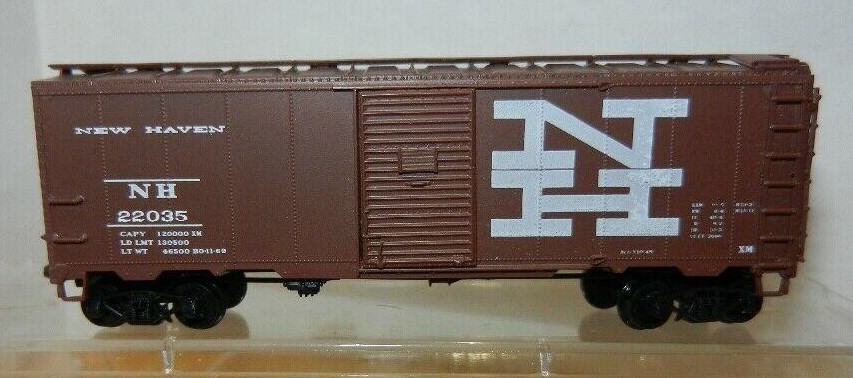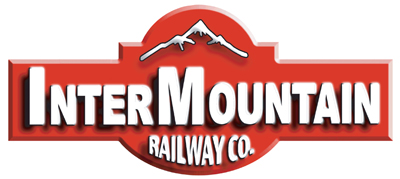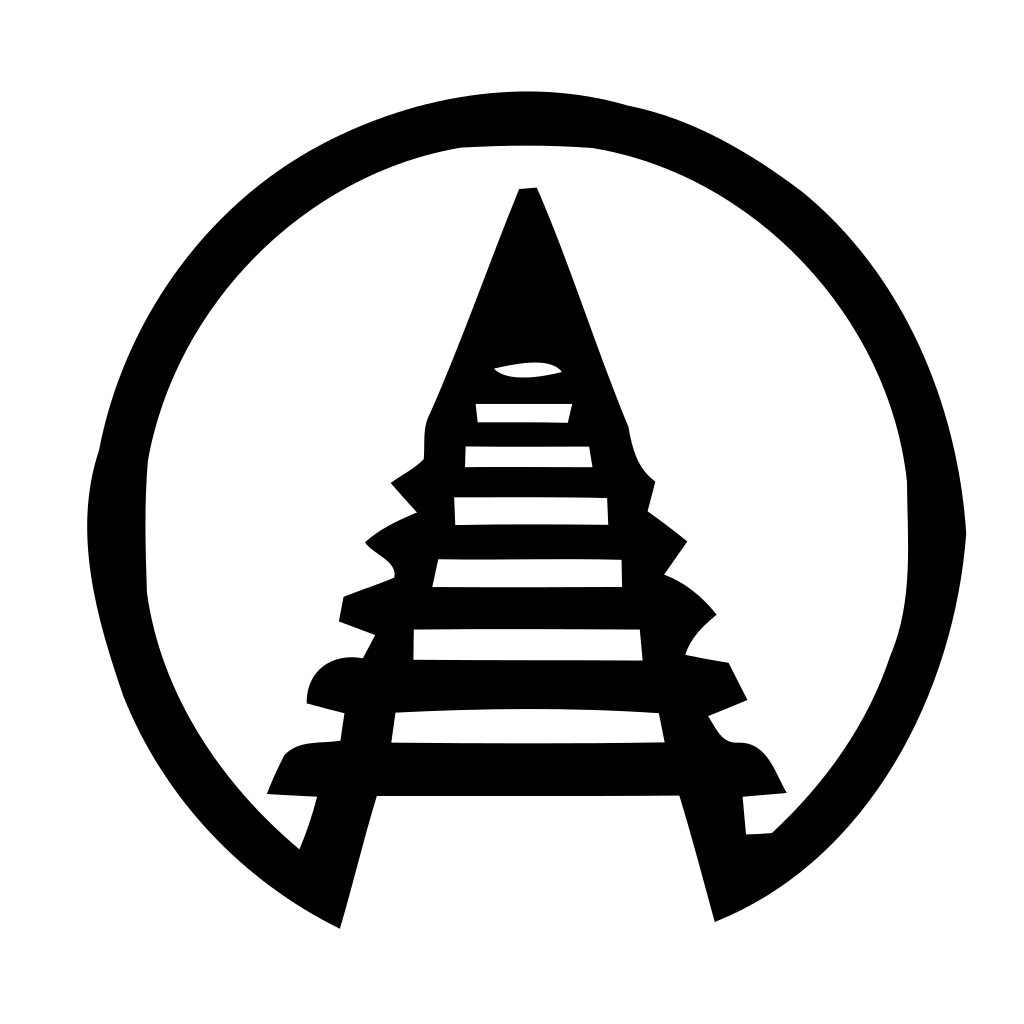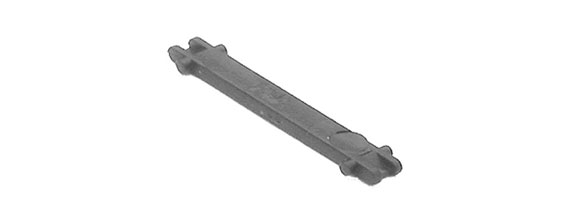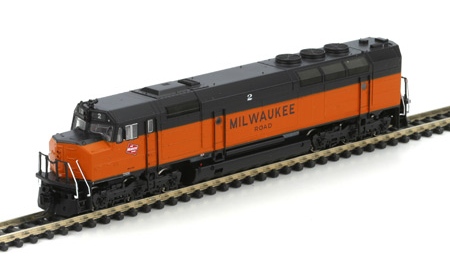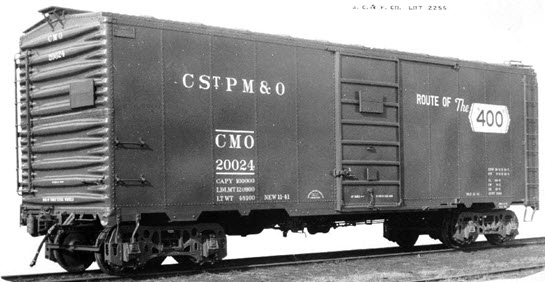Prototype History: The Association of American Railroads had been establishing design standards for freight cars since the early part of the century. Each new design standard meant higher capacity, lighter, more durable cars.
The Modified 1937 AAR boxcar design was a result of the industries continued search for more freight volume per carload. The real first attempt at a standardized design had been the 1932 ARA steel boxcar with an inside height of 9'-4" . In 1936 the board of the AAR approved the 1937 AAR design with a 10'-0" inside height. This became a standard throughout the industry.
The Modified 1937 AAR boxcar design was a result of the industries continued search for more freight volume per carload. The real first attempt at a standardized design had been the 1932 ARA steel boxcar with an inside height of 9'-4" . In 1936 the board of the AAR approved the 1937 AAR design with a 10'-0" inside height. This became a standard throughout the industry.
Road Name History: 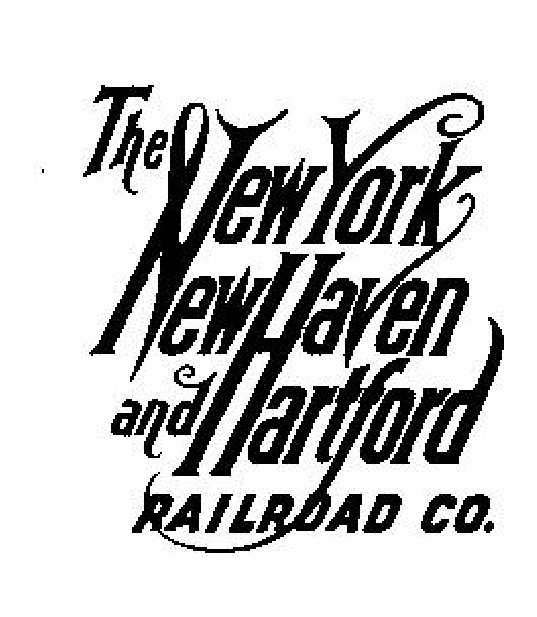 The New York, New Haven and Hartford Railroad (reporting mark NH), commonly known as the New Haven, was a railroad that operated in New England from 1872 to 1968, dominating the region's rail traffic for the first half of the 20th century.
The New York, New Haven and Hartford Railroad (reporting mark NH), commonly known as the New Haven, was a railroad that operated in New England from 1872 to 1968, dominating the region's rail traffic for the first half of the 20th century.
Beginning in the 1890s and accelerating in 1903, New York banker J. P. Morgan sought to monopolize New England transportation by arranging the NH's acquisition of 50 companies, including other railroads and steamship lines, and building a network of electrified trolley lines that provided interurban transportation for all of southern New England. By 1912, the New Haven operated more than 2,000 miles (3,200 km) of track, with 120,000 employees, and practically monopolized traffic in a wide swath from Boston to New York City.
This quest for monopoly angered Progressive Era reformers, alienated public opinion, resulted in high prices for acquisitions, and increased construction costs. Debt soared from $14 million in 1903 to $242 million in 1913, even as the advent of automobiles, trucks and buses reduced railroad profits. Also in 1913, the federal government filed an anti-trust lawsuit that forced the NH to divest its trolley systems.
The line became bankrupt in 1935, was reorganized and reduced in scope, went bankrupt again in 1961, and in 1969 was merged with the Penn Central system, formed a year earlier by the merger of the also bankrupt New York Central Railroad and Pennsylvania Railroad; Already a poorly conceived merger, Penn Central proceeded to go bankrupt in 1970, becoming the largest bankruptcy in the U.S. until the Enron Corporation superseded it in 2001. The remnants of the system now comprise Metro-North Railroad's New Haven Line, (parts of) Amtrak's Northeast Corridor, Shore Line East, parts of the MBTA, and numerous freight operators such as CSX and the Providence and Worcester Railroad. The majority of the system is now owned publicly by the states of Connecticut, Rhode Island, and Massachusetts.
Read more on Wikipedia and New Haven Railroad Historical and Technical Association, Inc.

Beginning in the 1890s and accelerating in 1903, New York banker J. P. Morgan sought to monopolize New England transportation by arranging the NH's acquisition of 50 companies, including other railroads and steamship lines, and building a network of electrified trolley lines that provided interurban transportation for all of southern New England. By 1912, the New Haven operated more than 2,000 miles (3,200 km) of track, with 120,000 employees, and practically monopolized traffic in a wide swath from Boston to New York City.
This quest for monopoly angered Progressive Era reformers, alienated public opinion, resulted in high prices for acquisitions, and increased construction costs. Debt soared from $14 million in 1903 to $242 million in 1913, even as the advent of automobiles, trucks and buses reduced railroad profits. Also in 1913, the federal government filed an anti-trust lawsuit that forced the NH to divest its trolley systems.
The line became bankrupt in 1935, was reorganized and reduced in scope, went bankrupt again in 1961, and in 1969 was merged with the Penn Central system, formed a year earlier by the merger of the also bankrupt New York Central Railroad and Pennsylvania Railroad; Already a poorly conceived merger, Penn Central proceeded to go bankrupt in 1970, becoming the largest bankruptcy in the U.S. until the Enron Corporation superseded it in 2001. The remnants of the system now comprise Metro-North Railroad's New Haven Line, (parts of) Amtrak's Northeast Corridor, Shore Line East, parts of the MBTA, and numerous freight operators such as CSX and the Providence and Worcester Railroad. The majority of the system is now owned publicly by the states of Connecticut, Rhode Island, and Massachusetts.
Read more on Wikipedia and New Haven Railroad Historical and Technical Association, Inc.
Brand/Importer Information: InterMountain was founded in 1985 by Fred Brummet. They got started in the model railroad business by producing O-Scale model kits. They got started in the N Scale business almost a decade later when in 1994 they introduced the 40-23 reefer car in kit form. Later, in 1998, they started producing RTR (Ready-to-Run) models. By the early 2000s, InterMountain phased out kit production in favor of the RTR models.
The InterMountain Railway company is located at 1224 Boston Ave in Longmont, CO. They are a manufacturer of HO, N and Z scale model trains. They have produced kits as well as RTR (Ready-To-Run) models. Their N Scale products include locomotives as well as rolling stock. Their rolling stock lineup includes Boxcars, Hoppers, Tank Cars, Reefers, Gondolas, Stock Cars and Flatcars.
Their locomotive releases have primarily been diesel units, with the one major exception being their series of AC-12 Cab Forward steam locos. Their diesel lineup includes F3's, F7's, F9's, SD40's, SD45's and FT units. They are known for quality and detail. They also release their rolling stock in larger varieties of road numbers than most of the other manufacturers.
The InterMountain Railway company is located at 1224 Boston Ave in Longmont, CO. They are a manufacturer of HO, N and Z scale model trains. They have produced kits as well as RTR (Ready-To-Run) models. Their N Scale products include locomotives as well as rolling stock. Their rolling stock lineup includes Boxcars, Hoppers, Tank Cars, Reefers, Gondolas, Stock Cars and Flatcars.
Their locomotive releases have primarily been diesel units, with the one major exception being their series of AC-12 Cab Forward steam locos. Their diesel lineup includes F3's, F7's, F9's, SD40's, SD45's and FT units. They are known for quality and detail. They also release their rolling stock in larger varieties of road numbers than most of the other manufacturers.
Commissioner Information:  Pacific Western Rail Systems (PWRS Retail Ltd.) is a model railroad store, and they also do a lot of special runs. They do most of their business by mail order. Please call ahead of time if you would like to visit in person.
Pacific Western Rail Systems (PWRS Retail Ltd.) is a model railroad store, and they also do a lot of special runs. They do most of their business by mail order. Please call ahead of time if you would like to visit in person.
Pacific Western Rail Systems is located south of Vancouver at 15515 24th Ave in Surrey, British Columbia, Canada.
Pacific Western Rail Systems (Co-Op), the club in Surrey, BC, created and developed PWRS Retailing, LTD. A lot of their original business was selling limited-run cars. PWRS Retailing, Ltd. is a business. It was formed because the club's relationship with suppliers grew from a few special run cars, to ordering some locomotives for members, to helping a few friends, to the point where it was a full-time job and a large investment. Volunteer labor was not sufficient. The main owners of the business are those individual members of the club who chose to invest their own money and time in the business. The club members each own a minority interest in the store, but the club and the store are separate entities. Some of the original goals, such as developing a showcase, interactive layout with a sales point for the public, remain works in progress, and the shareholders of PWRS plan other achievements for the future of model railroading as well.
PWRS is a company incorporated in the Province of British Columbia and is owned by over 130 individual model railroaders. Their shareholders live in Canada, USA, Switzerland, England, and Australia.
Pacific Western Rail Systems is located south of Vancouver at 15515 24th Ave in Surrey, British Columbia, Canada.
Pacific Western Rail Systems (Co-Op), the club in Surrey, BC, created and developed PWRS Retailing, LTD. A lot of their original business was selling limited-run cars. PWRS Retailing, Ltd. is a business. It was formed because the club's relationship with suppliers grew from a few special run cars, to ordering some locomotives for members, to helping a few friends, to the point where it was a full-time job and a large investment. Volunteer labor was not sufficient. The main owners of the business are those individual members of the club who chose to invest their own money and time in the business. The club members each own a minority interest in the store, but the club and the store are separate entities. Some of the original goals, such as developing a showcase, interactive layout with a sales point for the public, remain works in progress, and the shareholders of PWRS plan other achievements for the future of model railroading as well.
PWRS is a company incorporated in the Province of British Columbia and is owned by over 130 individual model railroaders. Their shareholders live in Canada, USA, Switzerland, England, and Australia.
Item created by: gdm on 2018-04-17 13:05:36
Last edited by: gdm on 2021-05-11 10:29:30
If you see errors or missing data in this entry, please feel free to log in and edit it. Anyone with a Gmail account can log in instantly.
Last edited by: gdm on 2021-05-11 10:29:30
If you see errors or missing data in this entry, please feel free to log in and edit it. Anyone with a Gmail account can log in instantly.


